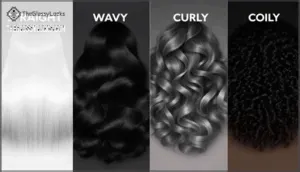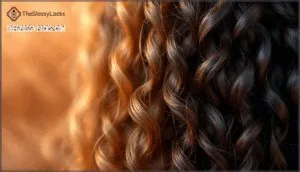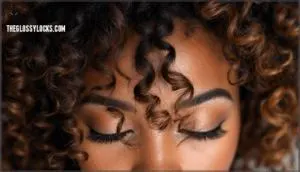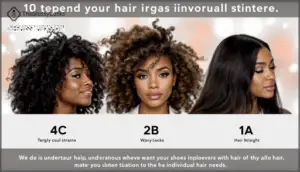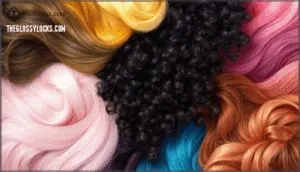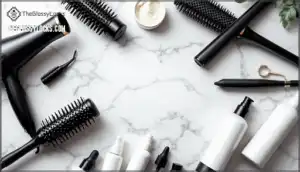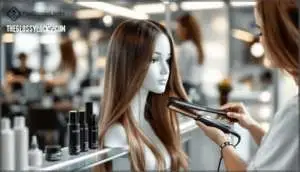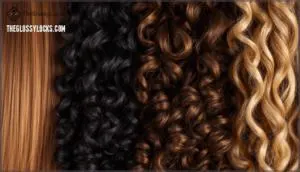This site is supported by our readers. We may earn a commission, at no cost to you, if you purchase through links.
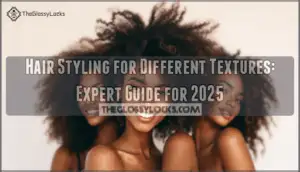
At least 75 genetic variants shape your hair’s curl pattern and thickness, which explains why one-size-fits-all advice rarely works. Understanding hair styling for different textures means learning what your specific hair needs to thrive. Once you know your texture and how it behaves, you can choose techniques that work with your hair instead of fighting against it.
Table Of Contents
- Key Takeaways
- What Are The Main Hair Textures?
- Identifying Your Hair Texture
- Key Factors Influencing Hair Styling
- Essential Styling Tools and Products
- Styling Techniques for Straight Hair
- Styling Techniques for Wavy Hair
- Styling Techniques for Curly and Coily Hair
- Maintaining Healthy Hair Across All Textures
- Frequently Asked Questions (FAQs)
- Conclusion
Key Takeaways
- Your hair texture is determined by at least 75 genetic variants that shape follicle form and curl pattern, which is why universal styling advice rarely works and you need texture-specific techniques instead.
- Porosity—how your hair absorbs and holds moisture—affects everything from product choice to styling results, with high-porosity hair losing water 50% faster under heat and requiring different care than low-porosity types.
- Protective styling and heat-free methods reduce breakage by 30-45% for curly and coily textures, while straight and wavy hair needs volumizing techniques and frizz control tailored to their sebum distribution patterns.
- Regular deep conditioning cuts brittleness by up to 60% in porous hair, and trimming every 6-8 weeks prevents split ends from traveling up the shaft and increasing frizz by 60%.
What Are The Main Hair Textures?
Hair texture starts at the follicle and shapes everything about how your hair behaves. The four main categories—straight, wavy, curly, and coily—each have distinct patterns that affect styling and care.
Here’s what sets each texture apart.
Straight, Wavy, Curly, and Coily Explained
Your hair texture comes down to one thing: your hair follicle shape. Round follicles give you straight hair while oval or curved ones create waves, curls, or coils. Here’s what you need to know about the four main hair types:
- Straight hair reflects light easily and is usually oily faster since sebum travels down the shaft without interference.
- Wavy hair forms an S-shape pattern and sits between straight and curly, often fighting frizz in humid weather.
- Curly and coily hair spiral tightly due to flattened follicles, creating beautiful curl patterns that need extra moisture to stay healthy.
Understanding your texture helps you choose the right hair care and styling approach for your unique curl pattern. Hair textures include straight, wavy, curly, or coily.
How Hair Texture is Determined
Genetic factors play a major role in determining your hair texture. At least 75 genetic variants influence your curl pattern and strand thickness. Follicle shape matters too—round follicles create straight hair while oval ones produce curls. Protein structure, specifically keratin and disulfide bonds, gives your hair its strength and curl tightness.
Hormonal influences like estrogen and testosterone affect follicle size and hair thickness. Ethnic variations also contribute to hair types, with specific genes more common in Asian, African, and European populations. The shape of the follicle determines hair’s overall texture.
Mixed Hair Textures on One Head
You might notice your crown curls tighter than your ends or your back sections wave while your sides spring into ringlets. Nearly 32% of people globally have multiple textures on one head due to genetic factors and follicle shape variations across the scalp.
Nearly a third of people worldwide have multiple hair textures on one head due to genetic factors and follicle shape variations
This creates real styling challenges—from uneven moisture absorption to frizz control—but understanding your hair texture variations helps you choose the right products and techniques for each section.
Identifying Your Hair Texture
Knowing your exact hair texture makes all the difference when choosing products and styles. Your curl pattern tells you how your hair behaves and what it needs to look its best.
Let’s break down how to identify your texture with confidence.
Hair Texture Vs. Hair Type
You might think texture and type mean the same thing, but they don’t. Hair texture describes strand diameter—fine, medium, or coarse—while hair type refers to your curl pattern, from straight to coily.
Understanding both hair characteristics matters because you can have fine wavy hair or coarse curly hair. Product selection works best when you consider texture vs. type together.
Many people also have mixed textures across their scalp, with hair texture variations in different areas.
Recognizing Curl Patterns and Subtypes
Curl patterns follow the Andre Walker system, dividing hair into Type 1 through Type 4, with subtypes A, B, and C. Type 3 features loose to tight spirals, while Type 4 shows coily or kinky patterns.
A hair texture chart helps you identify your curl type by comparing wave definition and coil tightness.
Ethnic variability affects curl patterns—African hair often displays Type 4, while European hair leans toward wavy patterns.
Understanding your curl type guides product choices and styling methods.
Can You Have Multiple Textures?
Yes, you can have multiple textures on one head—it’s more common than you’d think. About 30–40% of people worldwide have texture variations, especially around the crown or hairline.
Genetic factors and hormonal influences during puberty or pregnancy can reshape follicles, creating different curl patterns. Chemical impacts from heat or treatments also alter texture.
Caring for multiple hair textures means using targeted styling solutions for each zone.
Key Factors Influencing Hair Styling
Your hair texture isn’t the only thing that matters when you’re styling. Other factors like how your hair holds moisture and how healthy your scalp is can make or break your results.
Let’s look at the three main factors that affect how your hair reacts to styling.
Porosity and Moisture Retention
Your hair’s porosity—its ability to absorb and hold moisture—is like a gatekeeper for hydration. High-porosity hair soaks up water fast but loses it just as quickly, while low-porosity hair resists moisture altogether. Curly and coily textures naturally show higher porosity at twist points.
Chemical treatments, heat styling, and even UV exposure all degrade your cuticle and increase porosity over time.
Treatment approaches now include lipid-sealing conditioners and oils that temporarily smooth surface defects and improve moisture balance without true structural repair.
Density, Thickness, and Elasticity
Think of density, thickness, and elasticity as the three pillars that determine how your hair reacts to styling. Hair density—the number of strands per square inch—varies widely. Blondes average around 150,000 hairs per scalp, while those with black hair sit closer to 100,000.
Strand thickness differs too. Asian hair measures 0.08–0.12 mm in diameter, while European hair runs thinner at 0.04–0.1 mm. Hair elasticity, ranging from 2 to 10 GPa, controls how well your style holds without snapping.
Together, these traits shape hair volume and styling impact in ways you can’t ignore.
Impact of Scalp Health
Your scalp isn’t just skin—it’s the foundation for everything that grows from it. A 2024 study found over 75% correlation between scalp and follicle microbiome balance, directly influencing hair growth cycles. Poor scalp health shortens your growth phase and weakens strands.
Sebum regulation, environmental stressors, and lifestyle factors all impact follicular activity. In 2025, scalp innovations like rosemary serums and individualized treatments are reshaping hair wellness and maintenance routines.
Essential Styling Tools and Products
The right tools and products make all the difference when styling different hair textures. What works for straight hair won’t always work for coily hair, and knowing which tools to reach for saves time and prevents damage.
Let’s break down the essentials you need for your specific texture.
Brushes, Combs, and Heat Tools
Your tools shape your results. Wide-tooth combs prevent breakage in curly and coily hair, while paddle brushes smooth straight textures.
Heat tools like straighteners dominated 82.33% of the market in 2024, but hair damage spikes above 220°C. Look for ceramic plates and temperature controls to protect your strands.
AI-driven tools will soon adjust heat based on moisture levels, making styling safer and smarter.
Recommended Products for Each Texture
Once you know your tools, the right products make all the difference. Your texture determines what your hair actually needs.
- Straight-hair shampoos with panthenol cut breakage by 30% and keep your roots fresh without weighing you down.
- Wavy-hair serums with Marula oil boost hydration by 52% and tame frizz when humidity spikes.
- Curl-defining creams with shea butter deliver 60% more curl clarity and keep your pattern bouncy all day.
- Coily-hair gels made with flaxseed hold 80% of moisture for a full 24 hours after you apply them.
- Multi-texture stylers combining mousse and oil raise satisfaction by 28% for mixed curl patterns.
Match your products to your texture and you’ll see the difference fast.
Heat Protection and Moisturizing Essentials
Heat protectants are non-negotiable when styling with heat. Styling tools operate between 150°C and 230°C, causing rapid thermal damage. Polymer technology in modern protectants reduces breakage by over 30% and lowers strand temperature by 15–20°C. Moisture retention is equally important—high-porosity hair loses water 50% faster under heat. Pairing protectants with moisturizers containing glycerin and oils can boost elasticity by 35–40%.
| Hair Texture | Heat Protectant Type | Moisturizer Type |
|---|---|---|
| Straight | Light spray | Serum with silicones |
| Wavy/Curly | Cream or spray | Leave-in conditioner |
| Coily | Oil-based spray | Butter or gel |
Market growth underscores the efficacy of these products—heat protectants reached USD 3.84 billion in 2024. Your hair care routine should match protection to your hair texture and damage level.
Styling Techniques for Straight Hair
Straight hair might seem easy to style, but it comes with its own set of tricks. From adding body to keeping shine in check, there are specific methods that work best.
Here’s what you need to know to make straight hair look its best in 2025.
Creating Volume and Texture
Straight hair can fall flat without the right approach. Root lift starts with round-brush blowouts that create up to 30% more height than air-drying.
Texture enhancement comes from volumizing mousses that expand fiber diameter by 5–10%. Velcro rollers offer volume maintenance for up to 48 hours without heat damage.
Hybrid styling combines sleek roots with textured ends for structural contrast. Product layering with lightweight sprays keeps hair lifted throughout the day.
Managing Oiliness and Frizz
Your scalp produces around 1.0–1.5 grams of sebum daily. That buildup clogs follicles and raises folliculitis risk by 23%. Use shampoos with zinc or salicylic acid to cut oil output by 25% in four weeks.
Humidity above 65% swells hair fibers by 16–22%, triggering frizz. Anti-frizz serums with silicones reduce roughness by 55%, while argan oil blends offer 35% improvement. Chemical damage from coloring boosts porosity by 60%, worsening frizz under moisture.
Tech monitoring tools now track scalp sebum with 87% accuracy, helping you choose products that work.
Trendy Cuts and Styles for 2025
Face-framing layers and blunt ends rule the straight hair scene this year. Over 35% of clients prefer Italian and French bobs because they grow out gracefully and need minimal upkeep.
- Curtain bangs and invisible layering add motion without sacrificing length
- Textured lobs and side-parted cuts make a strong comeback in late 2025
- Gender-neutral pixies and hybrid bobs rose 34% in unisex salons
- Low-maintenance trending hairstyles with natural fall reflect the shift toward easy hair styling across all hair textures
Styling Techniques for Wavy Hair
Wavy hair sits right between straight and curly. It has its own set of challenges and opportunities.
Here’s how to make the most of your waves and keep them looking their best.
Enhancing and Defining Waves
Wavy hair thrives when you work with its natural pattern instead of against it. Your porosity matters—low porosity hair needs lightweight aloe-based products, while high porosity strands benefit from sealing oils like argan.
Try the squish to condish technique during conditioning to boost moisture distribution.
Drying methods shape your results: diffusing cuts time by 70% and improves wave uniformity, or alternate between air drying and diffusing for balance. Heatless techniques like silk curlers prevent breakage while creating beach waves.
The Curly Girl method works for wavy hair too—skip sulfates, wash 1–3 times weekly, and scrunch or plop for definition.
Frizz Control and Product Tips
Humidity swells your hair shaft by up to 50% when you have wavy texture, so layering products matters. Start with a hydrating leave-in conditioner, add argan oil serum for shine, then finish with a humidity-blocking gel. This system cuts frizz by 80%.
Heat-protective creams shield strands during styling, while keratin treatments from salons offer 4–6 months of smooth results. Choose silicone-free botanical serums for lightweight control without buildup.
Best Haircuts for Wavy Textures
Your best bets for wavy textures blend structure with movement. These haircuts dominate 2025 salons and simplify daily hair styling:
- Layered lobs – shoulder-length cuts with internal ghost layers boost volume by 20% and suit most wavy hair densities
- Textured shags – mid-length styles with slide-cutting preserve bounce while reducing bulk for medium hairstyles that last
- Cheek-length bobs – ideal for type 2A–2B wave definition with jawline framing that balances proportions
Trim every 6–8 weeks to prevent split ends and maintain shape. Smart layering techniques and proper length considerations keep your waves defined without extra effort.
Styling Techniques for Curly and Coily Hair
Curly and coily hair thrives when you work with its natural texture instead of against it. These textures need specific care because they’re more prone to dryness and breakage than straighter types.
Let’s look at the key techniques that keep curls and coils healthy and defined.
Moisturizing and Detangling Methods
Curly and coily hair needs moisture like a sponge needs water. Your best move is detangling while damp—it cuts breakage by 40% compared to dry combing. Use your fingers or flexible-bristle tools to minimize tension on each strand.
Apply leave-in conditioners or detangling sprays to drop combing resistance by 60%. Follow with moisturizing masks containing aloe vera or glycerin for better product absorption and stronger structural integrity over time.
Protective Styles and Heat-Free Options
Protective styles like braids and twists shield your strands from daily wear while promoting hair styling goals like length retention and scalp health. These methods lower breakage rates by 30% and support cultural significance across communities.
Heat-free options using flexi rods or bantu knots preserve fiber innovation by reducing cuticle damage 45%. Focus on tension control during installation to prevent traction issues.
Proper hair care routines maintain natural hair texture while extending style longevity through reduced manipulation.
Diffusing, Twisting, and Braiding Techniques
You can layer techniques to tackle different goals. A diffuser on low heat preserves curl definition by 45% and cuts frizz when held 15 cm away.
Twist-outs hold 20–25% more moisture than braid-outs and reduce frizz by 30% with protein gels. Braid-outs give wave patterns but raise frizz 10–15% in humidity.
Hybrid styling—mixing twists and braids—boosts hold 25% in damp weather.
Keep wet-to-dry styling under 60°C to avoid diffuser heat damage and braid tension risks at the hairline.
Maintaining Healthy Hair Across All Textures
Healthy hair starts with smart habits that work for your specific texture. The basics stay the same across all hair types, but the techniques vary depending on whether your strands are straight, wavy, curly, or coily.
Here’s what you need to focus on to keep your hair strong and thriving.
Preventing Breakage and Split Ends
Keeping your strands strong means understanding what causes hair breakage and hair damage. Chemical treatments and heat damage from tools above 150°C weaken keratin and reduce elasticity by up to 50%. Environmental factors like UV rays and pollution create tiny cracks in your hair. Protein balance matters too—too much makes hair brittle while too little leaves it limp.
Trimming frequency every six to eight weeks stops split ends from traveling up the shaft. Between cuts, protective styles reduce daily friction. Hair maintenance becomes easier when you use heat protectants and avoid tight hairstyles that stress follicles.
Deep Conditioning and Oil Treatments
Beyond preventing breakage, your hair needs regular moisture boosts. Deep conditioning works like a reset button for dry strands. Weekly treatments cut brittleness by up to 60% in porous hair, while heat application during conditioning raises moisture absorption by 25% in low porosity types.
Here’s your texture-specific game plan:
- High porosity and chemically treated hair – Deep condition twice weekly with a protein-moisture balance to stop the 68% breakage rate common in processed strands.
- Low porosity hair – Apply heat or steam every 10 to 14 days since tightly sealed cuticles need extra help absorbing treatments.
- All textures – Rotate protein treatments monthly with moisture masks to avoid overload and maintain elasticity improvements of up to 40%.
Oil treatments greatly enhance growth too. Ayurvedic blends reduced hair fall by 76% in eight-week studies, while coconut and jojoba oils boosted thickness and shine. DIY masks with aloe vera and natural oils give you custom solutions without harsh chemicals—your hair porosity and climate should guide your schedule.
Regular Trims and Damage Prevention
Trims sit at the core of damage prevention and length retention. You should trim every six to eight weeks to stop split ends before they unravel up the shaft and increase frizz by 60%. Professional trims reduce breakage risk by 20% compared to dull home scissors.
Pair your trim frequency with sulfate-free products and fabric hair ties to protect fiber strength between salon visits.
Frequently Asked Questions (FAQs)
How often should I wash different hair textures?
Your hair texture shapes how sebum production rates affect washing frequency. Straight hair needs washing daily or every other day because oil travels fast down the shaft. Wavy hair types benefit from 2-3 weekly washes, while curly and coily textures retain moisture better with weekly or biweekly washing.
Over-washing effects include dryness and breakage—under-washing consequences bring buildup and scalp issues. Let scalp condition impact and washing frequency factors guide your hair care routine.
Can hair texture change naturally over time?
Yes, your hair texture can shift naturally over time. Hormonal influence during pregnancy or menopause often changes curl patterns. Aging hair generally becomes finer or straighter as fiber diameter decreases.
Genetic factors, medical conditions, and nutritional impact also play roles in texture evolution.
What causes hair texture to become damaged?
Like a protective shield slowly cracking under pressure, your hair faces threats from multiple angles. Chemical Damage from bleaching and relaxers breaks down keratin bonds. Heat Exposure above 200°F weakens hair elasticity. Mechanical Stress from tight styles causes hair breakage.
Environmental Impact through UV rays and pollutants reduces strength.
Nutritional Factors like low biotin affect hair treatment outcomes, altering hair porosity and overall texture integrity.
How do I transition from chemical treatments safely?
Moving away from relaxers or perms takes patience. You can do a big chop to remove all treated hair at once or try a gradual shift over six to eighteen months.
Focus on damage repair with protein treatments to restore hair elasticity and prevent hair breakage. Choose sulfate-free products and use protective styling like braids to minimize hair damage during this vulnerable phase.
Should I use salon or at-home styling methods?
Both approaches have merit. Salons offer professional expertise and damage prevention through controlled treatments, but cost $50 to $200+ per visit.
At-home styling saves time and money with proper hair products and techniques, though results may be shorter-lived without stylist-level skill.
Conclusion
Think of your hair like a conversation partner—it responds best when you speak its language. Hair styling for different textures isn’t about forcing your strands into submission. It’s about listening to what they need and working together.
The products you choose and the techniques you practice should honor your natural pattern instead of fighting it. When you understand your texture and treat it right, styling stops being a battle. Your hair becomes easier to manage and looks healthier every single day.
- https://www.grandviewresearch.com/industry-analysis/hair-texturizer-market-report
- https://associatedbarbercollege.edu/understanding-hair-textures-and-how-to-work-with-all-hair-types/
- https://pmc.ncbi.nlm.nih.gov/articles/PMC11846515/
- https://onlinelibrary.wiley.com/doi/10.1111/jocd.12892
- https://www.curlynikki.com/why-you-should-protective-style-more.html

